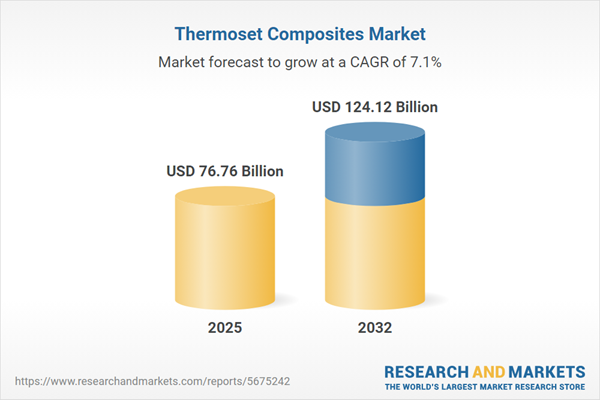Speak directly to the analyst to clarify any post sales queries you may have.
Thermoset composites play a pivotal role in modern manufacturing, offering adaptable, high-performance solutions that empower organizations to navigate regulatory change, drive innovation, and maintain resilience in evolving markets.
Market Snapshot: Thermoset Composites Market Overview
The global thermoset composites market is set for robust growth, projected to reach USD 124.12 billion by 2032, up from USD 71.75 billion in 2024, marking a 7.09% CAGR. This trajectory highlights sustained corporate investment in strong, thermally resistant, and durable materials that address new compliance demands and competitive pressures across key industrial segments. Senior leaders are focusing on thermoset composites to advance operational agility and reinforce business continuity amid technological disruptions and tightening regulations. As efficiency and adaptability remain priorities, this trend signals a shift towards greater reliance on material-driven process enhancements within executive strategies.
Scope & Segmentation: Full Value Chain Insights
- Resin Types: Epoxy, phenolic, polyester, polyurethane, and vinyl ester resins are selected for their robust mechanical strength and thermal stability, finding application in aviation, construction, and industrial machinery projects where reliability is vital.
- Fiber Variants: Aramid, carbon, glass, and natural fibers provide manufacturers and engineers with lightweight yet structurally sound solutions. These options support innovation in automotive, energy, and transportation by enabling efficiency improvements through weight reduction and enhanced reliability.
- Manufacturing Processes: Compression molding, filament winding, hand lay-up, pultrusion, resin transfer molding, and spray-up accommodate both high-volume and custom manufacturing. These methods empower organizations to meet varied regulatory specifications while maintaining consistency and scalability.
- Application Segments: Aerospace, defense, automotive, construction, electronics, marine, sports, leisure, and renewables sectors leverage thermoset composites to increase durability and enable peak performance under challenging and often hostile conditions.
- End Use Industries: Oil and gas, marine, and renewable energy sectors turn to these advanced materials to prolong asset lifespan, reduce maintenance requirements, and align projects with evolving sustainability mandates.
- Regional Coverage: The Americas, Europe, Middle East and Africa, and Asia-Pacific each present distinct regulatory frameworks, investment climates, and infrastructure landscapes. This diversity requires region-specific development strategies and careful alignment with local compliance expectations.
- Leading Companies: Organizations such as Owens Corning, Toray Industries, Hexcel Corporation, SGL Carbon SE, Gurit Holding AG, Solvay SA, Hexion Inc., Huntsman Corporation, Mitsubishi Chemical Holdings Corporation, and Ashland Global Holdings are recognized for advancing innovation and setting benchmarks throughout the value chain.
Key Takeaways: Strategic Insights for Market Leaders
- Continuous advancements in material chemistry and formulation are expanding the adoption of thermoset composites, enabling firms to enhance compliance, sustainability, and production reliability within their operations.
- Adoption of bio-based and recycled composite materials is growing, reflecting the industry’s response to increasing stakeholder focus on circularity and sustainability.
- Integrated approaches across the value chain help producers establish operational consistency, employ best practices, and effectively minimize waste in manufacturing and deployment.
- Deployment of digitalization technologies, including real-time analytics and predictive maintenance, grants decision-makers improved oversight into plant operations while strengthening data-driven agility.
- Localized sourcing and manufacturing increase business flexibility, allowing companies to adapt rapidly to evolving market needs and unique local compliance standards.
- Progress in automation supports scalable production and streamlines adaptation to regulatory updates, strengthening organizational readiness to address changing compliance landscapes.
Tariff Impact: Navigating Supply Chain Shifts
Imminent U.S. tariff changes are driving procurement leaders to reassess sourcing and risk management strategies within the thermoset composites sector. Initiatives such as broadening supplier networks, fostering local content, and optimizing inventory approaches are reducing the risk of supply interruptions. Strengthening ties with key partners in automotive, marine, and wind energy supply chains is helping organizations bolster operational resilience. Ongoing scenario planning and cross-functional coordination are further supporting continuity as businesses respond to evolving trade policy.
Methodology & Data Sources
This report is grounded in interviews with senior industry executives and consultants, and incorporates in-depth analysis of published data, patent filings, and exclusive sector databases. This multi-source approach delivers actionable, executive-level insights and ensures relevance for corporate decision-makers.
Why This Report Matters for Senior Leaders
- Enables proactive strategic planning by delivering timely analysis on thermoset composites and their role in advanced operational models.
- Equips decision-makers to strengthen supply chain resilience and align technical capability with regulatory and market developments.
- Offers detailed segmentation and regional perspectives to support informed investment strategies and effective risk management globally.
Conclusion
This executive analysis provides clarity for senior teams seeking to manage cycles of innovation and supply chain adjustment, supporting sustained efficiency and strategic positioning as industry dynamics progress.
Additional Product Information:
- Purchase of this report includes 1 year online access with quarterly updates.
- This report can be updated on request. Please contact our Customer Experience team using the Ask a Question widget on our website.
Table of Contents
3. Executive Summary
4. Market Overview
7. Cumulative Impact of Artificial Intelligence 2025
Companies Mentioned
The companies profiled in this Thermoset Composites market report include:- Owens Corning
- Toray Industries, Inc.
- Hexcel Corporation
- SGL Carbon SE
- Gurit Holding AG
- Solvay SA
- Hexion Inc.
- Huntsman Corporation
- Mitsubishi Chemical Holdings Corporation
- Ashland Global Holdings Inc.
Table Information
| Report Attribute | Details |
|---|---|
| No. of Pages | 188 |
| Published | October 2025 |
| Forecast Period | 2025 - 2032 |
| Estimated Market Value ( USD | $ 76.76 Billion |
| Forecasted Market Value ( USD | $ 124.12 Billion |
| Compound Annual Growth Rate | 7.0% |
| Regions Covered | Global |
| No. of Companies Mentioned | 11 |









